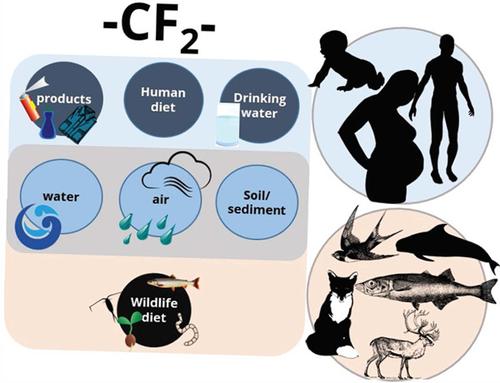当前位置:
X-MOL 学术
›
Environ. Toxicol. Chem.
›
论文详情
Our official English website, www.x-mol.net, welcomes your
feedback! (Note: you will need to create a separate account there.)
PFAS Exposure Pathways for Humans and Wildlife: A Synthesis of Current Knowledge and Key Gaps in Understanding
Environmental Toxicology and Chemistry ( IF 3.6 ) Pub Date : 2020-11-17 , DOI: 10.1002/etc.4935 Amila O De Silva 1 , James M Armitage 2 , Thomas A Bruton 3 , Clifton Dassuncao 4 , Wendy Heiger-Bernays 5 , Xindi C Hu 6 , Anna Kärrman 7 , Barry Kelly 8 , Carla Ng 9 , Anna Robuck 10 , Mei Sun 11 , Thomas F Webster 5 , Elsie M Sunderland 12
Environmental Toxicology and Chemistry ( IF 3.6 ) Pub Date : 2020-11-17 , DOI: 10.1002/etc.4935 Amila O De Silva 1 , James M Armitage 2 , Thomas A Bruton 3 , Clifton Dassuncao 4 , Wendy Heiger-Bernays 5 , Xindi C Hu 6 , Anna Kärrman 7 , Barry Kelly 8 , Carla Ng 9 , Anna Robuck 10 , Mei Sun 11 , Thomas F Webster 5 , Elsie M Sunderland 12
Affiliation

|
We synthesize current understanding of the magnitudes and methods for assessing human and wildlife exposures to poly‐ and perfluoroalkyl substances (PFAS). Most human exposure assessments have focused on 2 to 5 legacy PFAS, and wildlife assessments are typically limited to targeted PFAS (up to ~30 substances). However, shifts in chemical production are occurring rapidly, and targeted methods for detecting PFAS have not kept pace with these changes. Total fluorine measurements complemented by suspect screening using high‐resolution mass spectrometry are thus emerging as essential tools for PFAS exposure assessment. Such methods enable researchers to better understand contributions from precursor compounds that degrade into terminal perfluoroalkyl acids. Available data suggest that diet is the major human exposure pathway for some PFAS, but there is large variability across populations and PFAS compounds. Additional data on total fluorine in exposure media and the fraction of unidentified organofluorine are needed. Drinking water has been established as the major exposure source in contaminated communities. As water supplies are remediated, for the general population, exposures from dust, personal care products, indoor environments, and other sources may be more important. A major challenge for exposure assessments is the lack of statistically representative population surveys. For wildlife, bioaccumulation processes differ substantially between PFAS and neutral lipophilic organic compounds, prompting a reevaluation of traditional bioaccumulation metrics. There is evidence that both phospholipids and proteins are important for the tissue partitioning and accumulation of PFAS. New mechanistic models for PFAS bioaccumulation are being developed that will assist in wildlife risk evaluations. Environ Toxicol Chem 2021;40:631–657. © 2020 SETAC
中文翻译:

人类和野生动物的 PFAS 暴露途径:当前知识的综合和理解上的主要差距
我们综合了目前对评估人类和野生动物接触多氟烷基物质和全氟烷基物质 (PFAS) 的程度和方法的理解。大多数人类暴露评估都集中在 2 到 5 种传统 PFAS 上,而野生动物评估通常仅限于目标 PFAS(最多约 30 种物质)。然而,化学品生产的变化正在迅速发生,而检测 PFAS 的针对性方法却未能跟上这些变化的步伐。因此,总氟测量辅以高分辨率质谱可疑筛查,已成为 PFAS 暴露评估的重要工具。这些方法使研究人员能够更好地了解降解为末端全氟烷基酸的前体化合物的贡献。现有数据表明,饮食是人类接触某些 PFAS 的主要途径,但不同人群和 PFAS 化合物之间存在很大差异。需要有关暴露介质中总氟和未识别有机氟比例的额外数据。饮用水已被确定为受污染社区的主要暴露源。随着供水系统的修复,对于普通人群来说,灰尘、个人护理产品、室内环境和其他来源的接触可能更加重要。暴露评估的一个主要挑战是缺乏具有统计代表性的人口调查。对于野生动物来说,PFAS 和中性亲脂性有机化合物的生物累积过程存在很大差异,这促使人们重新评估传统的生物累积指标。有证据表明磷脂和蛋白质对于 PFAS 的组织分配和积累都很重要。 PFAS 生物累积的新机制模型正在开发中,这将有助于野生动物风险评估。环境毒理学化学2021;40:631–657。© 2020 SETAC 版权所有
更新日期:2020-11-17
中文翻译:

人类和野生动物的 PFAS 暴露途径:当前知识的综合和理解上的主要差距
我们综合了目前对评估人类和野生动物接触多氟烷基物质和全氟烷基物质 (PFAS) 的程度和方法的理解。大多数人类暴露评估都集中在 2 到 5 种传统 PFAS 上,而野生动物评估通常仅限于目标 PFAS(最多约 30 种物质)。然而,化学品生产的变化正在迅速发生,而检测 PFAS 的针对性方法却未能跟上这些变化的步伐。因此,总氟测量辅以高分辨率质谱可疑筛查,已成为 PFAS 暴露评估的重要工具。这些方法使研究人员能够更好地了解降解为末端全氟烷基酸的前体化合物的贡献。现有数据表明,饮食是人类接触某些 PFAS 的主要途径,但不同人群和 PFAS 化合物之间存在很大差异。需要有关暴露介质中总氟和未识别有机氟比例的额外数据。饮用水已被确定为受污染社区的主要暴露源。随着供水系统的修复,对于普通人群来说,灰尘、个人护理产品、室内环境和其他来源的接触可能更加重要。暴露评估的一个主要挑战是缺乏具有统计代表性的人口调查。对于野生动物来说,PFAS 和中性亲脂性有机化合物的生物累积过程存在很大差异,这促使人们重新评估传统的生物累积指标。有证据表明磷脂和蛋白质对于 PFAS 的组织分配和积累都很重要。 PFAS 生物累积的新机制模型正在开发中,这将有助于野生动物风险评估。环境毒理学化学2021;40:631–657。© 2020 SETAC 版权所有











































 京公网安备 11010802027423号
京公网安备 11010802027423号